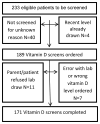Screening for vitamin D insufficiency in pediatric cancer survivors
- PMID: 24194420
- PMCID: PMC3946287
- DOI: 10.1002/pbc.24844
Screening for vitamin D insufficiency in pediatric cancer survivors
Abstract
Background: Corticosteroids increase risk for decreased bone mineral density, which can be worsened by vitamin D insufficiency (VDI) or deficiency (VDD).
Procedure: In the Vanderbilt cancer survivorship clinic, we obtained screening total 25-hydroxy vitamin D levels (VDL) in 171 cancer survivors <23 years old who were treated with prolonged corticosteroids for their cancer, and compared this group to a control group of 97 healthy pediatric patients.
Results: VDD was diagnosed in 15.8% and VDI in 34.5% of cancer survivors and VDD/VDI combined was associated with body mass index (BMI) >85th percentile (Odds ratio [OR] = 5.4; P < 0.001), older age (OR = 2.2; P = 0.012), non-Caucasian or Hispanic race (OR = 4.5; P = 0.008) and summer versus winter season (OR = 0.12; P < 0.001). In multivariable analysis, VDI/VDD prevalence did not differ from the control group (VDI/VDD (43.3%)). In the combined survivor/control group multivariable analysis, cancer diagnosis did not increase VDI/VDD risk, but significant associations persisted with elevated BMI (P < 0.001), age (P = 0.004), non-Caucasian or Hispanic race (P < 0.001), and seasonality (P < 0.001).
Conclusion: VDD/VDI is equally common in pediatric cancer survivors treated with corticosteroids and healthy children. The impact of VDD/VDI in cancer survivors may be greater due to risk for impaired bone health superimposed on that conferred from corticosteroid exposure. Thus, screening VDLs should be obtained in pediatric cancer survivors treated with corticosteroids, particularly in those with elevated BMI, older age, or non-Caucasian race. Prospective studies evaluating the impact of interventions to minimize VDD/VDI on long-term bone health in survivors are required.
Keywords: all; survivorship; vitamin D sufficiency.
© 2013 Wiley Periodicals, Inc.
Similar articles
-
Low vitamin D level in pediatric patients with new onset type 1 diabetes is common, especially if in ketoacidosis.Pediatr Diabetes. 2016 Dec;17(8):592-598. doi: 10.1111/pedi.12342. Epub 2015 Dec 23. Pediatr Diabetes. 2016. PMID: 26694737
-
Infants' Vitamin D Nutritional Status in the First Year of Life in Northern Taiwan.Nutrients. 2020 Feb 4;12(2):404. doi: 10.3390/nu12020404. Nutrients. 2020. PMID: 32033065 Free PMC article.
-
Vitamin D Status in Egyptian Adolescent Females with Iron Deficiency Anemia and Its Correlation with Serum Iron Indices.Endocr Metab Immune Disord Drug Targets. 2019;19(4):519-525. doi: 10.2174/1871530318666181029160242. Endocr Metab Immune Disord Drug Targets. 2019. PMID: 30370867
-
The Convergence of Two Epidemics: Vitamin D Deficiency in Obese School-aged Children.J Pediatr Nurs. 2018 Jan-Feb;38:20-26. doi: 10.1016/j.pedn.2017.10.005. Epub 2017 Oct 18. J Pediatr Nurs. 2018. PMID: 29167076 Review.
-
Interventions for Prevention and Control of Epidemic of Vitamin D Deficiency.Indian J Pediatr. 2019 Jun;86(6):532-537. doi: 10.1007/s12098-019-02857-z. Epub 2019 Jan 16. Indian J Pediatr. 2019. PMID: 30648226 Review.
Cited by
-
Sun Exposure and Protection Habits in Pediatric Patients with a History of Malignancy.PLoS One. 2015 Sep 8;10(9):e0137453. doi: 10.1371/journal.pone.0137453. eCollection 2015. PLoS One. 2015. PMID: 26348212 Free PMC article.
-
Vitamin D Deficiency in Childhood Cancer Survivors: Results from Southern Thailand.Nutrients. 2023 Mar 8;15(6):1328. doi: 10.3390/nu15061328. Nutrients. 2023. PMID: 36986058 Free PMC article.
-
Sociodemographic and clinical characteristics associated with vitamin D status in newly diagnosed pediatric cancer patients.Pediatr Hematol Oncol. 2020 May;37(4):314-325. doi: 10.1080/08880018.2020.1721629. Epub 2020 Mar 10. Pediatr Hematol Oncol. 2020. PMID: 32153233 Free PMC article. Clinical Trial.
-
Vitamin D Deficiency and Carotid Media-Intima Thickness in Childhood Cancer Survivors.Nutrients. 2023 May 16;15(10):2333. doi: 10.3390/nu15102333. Nutrients. 2023. PMID: 37242216 Free PMC article.
-
Bone mineral density surveillance for childhood, adolescent, and young adult cancer survivors: evidence-based recommendations from the International Late Effects of Childhood Cancer Guideline Harmonization Group.Lancet Diabetes Endocrinol. 2021 Sep;9(9):622-637. doi: 10.1016/S2213-8587(21)00173-X. Epub 2021 Jul 30. Lancet Diabetes Endocrinol. 2021. PMID: 34339631 Free PMC article. Review.
References
-
- Horner MJRL, Krapcho M, et al. Seer cancer statistics review, 1975–2006. Bethesda, MD: National Cancer Institue; 2009. p. 2009. http://seer.cancer.gov/csr/1975_2006/, based on Novemeber 2008 SEER data submission, posted to the SEER web site.
-
- Kremer LC, Mulder RL, Oeffinger KC, et al. A worldwide collaboration to harmonize guidelines for the long-term follow-up of childhood and young adult cancer survivors: A report from the international late effects of childhood cancer guideline harmonization group. Pediatr Blood Cancer. 2013;60:543–549. - PMC - PubMed
-
- Landier W, Wallace WH, Hudson MM. Long-term follow-up of pediatric cancer survivors: Education, surveillance, and screening. Pediatr Blood Cancer. 2006;46:149–158. - PubMed
Publication types
MeSH terms
Grants and funding
LinkOut - more resources
Full Text Sources
Other Literature Sources
Medical



